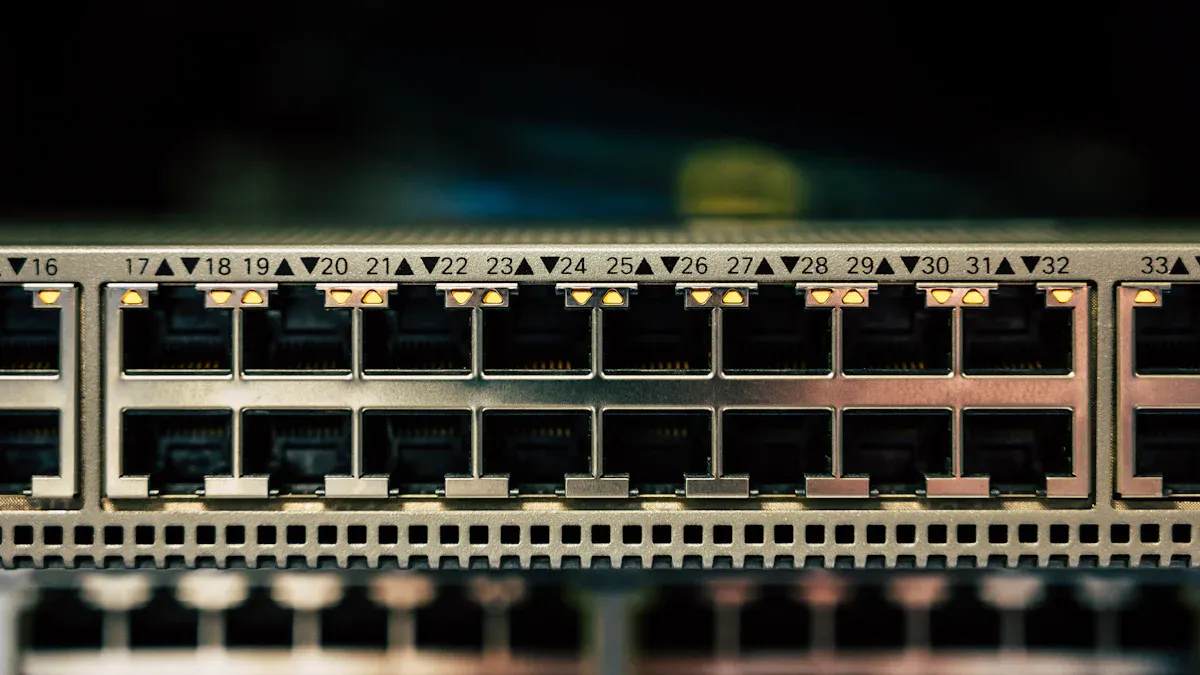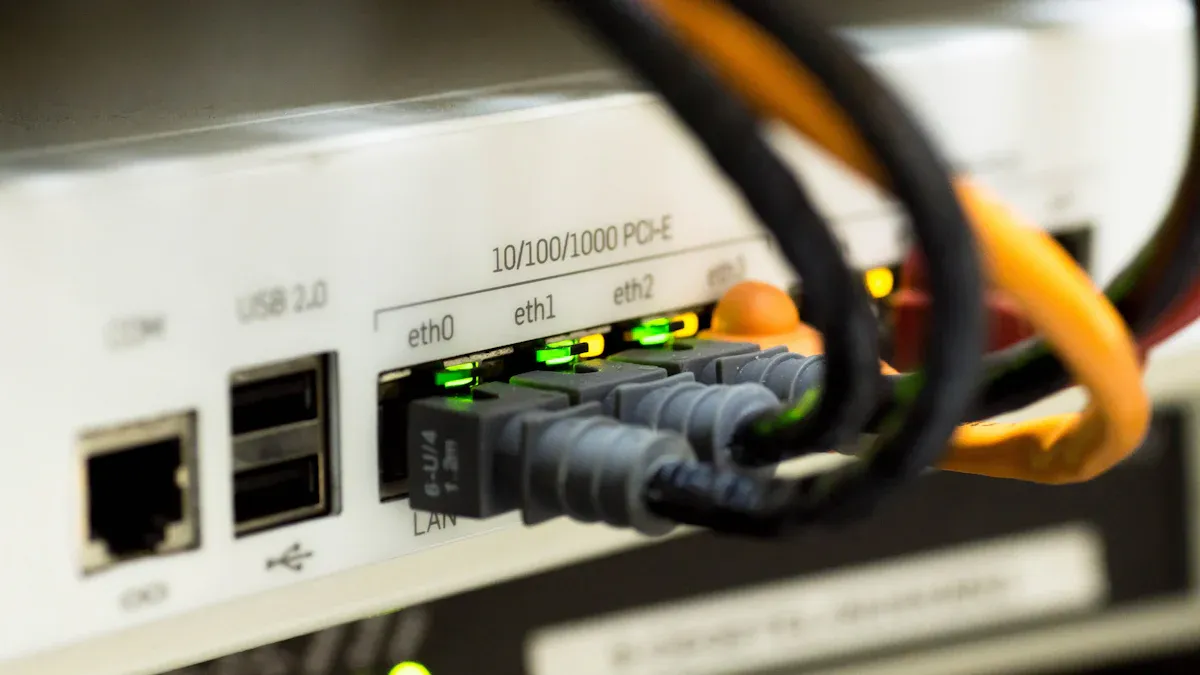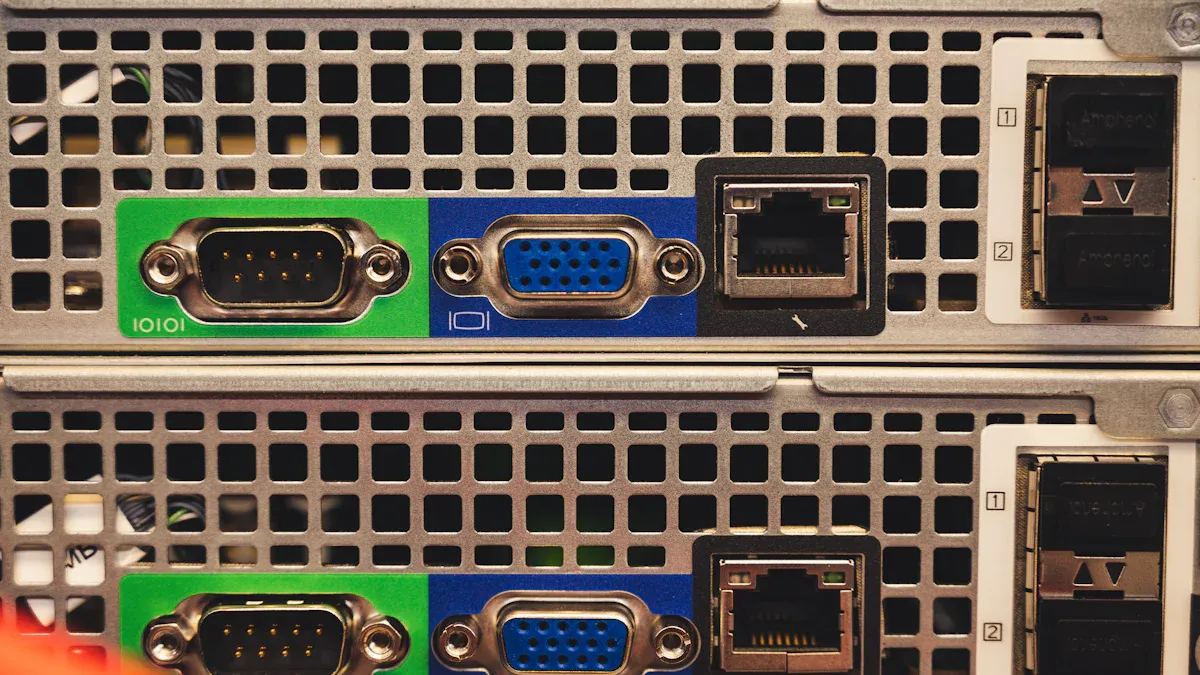What is a Fast Ethernet Transceiver IC and How Does It Work

A Fast Ethernet Transceiver IC is a specialized chip designed to handle Ethernet communication. It plays a critical role in transmitting data at speeds of up to 100 Mbit/s, ensuring fast and reliable connections. This technology is essential for modern networking, where efficiency and speed are key.
The demand for high-speed data communication continues to grow. Here's why Fast Ethernet Transceiver ICs are vital in today's world:
The rise of internet-enabled devices and cloud computing has caused an exponential increase in data traffic.
Large-scale data centers and telecom networks rely on these ICs for efficient data handling.
Advanced applications now require higher bandwidth and faster transmission speeds.
Fast Ethernet Transceiver ICs meet these demands, making them indispensable in various industries.
Key Takeaways
Fast Ethernet Transceiver ICs help transfer data up to 100 Mbps. This makes them important for today's networking needs.
These ICs work in many devices like network tools, industrial machines, and IoT gadgets. They ensure steady communication.
A big advantage of these ICs is saving energy. This lowers costs and helps the environment.
Their small size makes them easy to fit into devices. They are great for things like smart TVs and gaming systems.
When picking a Fast Ethernet Transceiver IC, look for features. Tools for checking problems and saving energy improve performance and reliability.
How Does a Fast Ethernet Transceiver IC Work?

Overview of Ethernet Communication
Ethernet communication forms the backbone of modern networking. It allows devices to exchange data over a wired connection using a standardized protocol. This protocol ensures that data packets travel efficiently between devices, minimizing errors and delays. Ethernet technology has evolved significantly, offering faster speeds and greater reliability. For example, modern industrial Ethernet protocols now support speeds ranging from 100 Mbps to 1 Gbps. These advancements enable you to handle more demanding applications, such as controlling machinery or processing real-time sensor data.
One of Ethernet's key strengths is its scalability. It can support an almost unlimited number of connected devices, making it ideal for large-scale networks. This scalability is especially important in industrial settings, where you might need to connect hundreds or even thousands of devices. By using Ethernet, you can achieve high-speed communication while maintaining the flexibility to expand your network as needed.
Key Components of a Fast Ethernet Transceiver IC
A Fast Ethernet Transceiver IC contains several critical components that work together to enable efficient data transmission. These components include:
Ethernet PHY (Physical Layer): This part handles the physical connection to the network. It uses coding and modulation techniques, such as 4B/5B or 8B/10B encoding, to ensure reliable data transfer over Cat5 UTP cables. The PHY also includes internal termination resistors to maintain signal integrity and reduce noise.
Ethernet Magnetics: These include isolation transformers and common-mode chokes. They protect the circuit from electrical interference and ensure compliance with electromagnetic compatibility (EMC) standards.
Clock and Timing Circuits: These circuits provide the precise timing needed for data encoding and decoding. Without accurate timing, the transceiver cannot process data correctly.
Media Independent Interface (MII): This interface connects the PHY to the MAC (Media Access Control) layer, enabling seamless communication between the hardware and software layers of the network.
Each of these components plays a vital role in ensuring that the Fast Ethernet Transceiver IC operates reliably. For example, the Ethernet PHY's modulation techniques help overcome physical limitations, while the magnetics ensure the circuit meets strict industry standards.
Data Transmission Process
The data transmission process in a Fast Ethernet Transceiver IC involves several steps. First, the device receives data from the network's MAC layer. This data is then encoded using specific modulation techniques, such as 4B/5B encoding, to prepare it for transmission over the physical medium. The encoded data passes through the Ethernet PHY, which converts it into electrical signals suitable for transmission over Cat5 cables.
Next, the signals travel through the Ethernet magnetics, which filter out noise and protect the circuit from electrical interference. Once the data reaches its destination, the receiving transceiver reverses the process. It decodes the electrical signals back into digital data and sends it to the MAC layer for further processing.
This process happens at incredibly high speeds, allowing you to transfer large amounts of data in a fraction of a second. The precise timing provided by the transceiver's clock circuits ensures that the data remains accurate and error-free throughout the transmission.
Applications of Fast Ethernet Transceiver ICs

Fast Ethernet Transceiver ICs play a pivotal role in various industries, enabling efficient and reliable communication. Their versatility makes them indispensable in networking equipment, industrial systems, IoT devices, and consumer electronics.
Networking Equipment
Networking equipment relies heavily on Fast Ethernet Transceiver ICs to ensure seamless data transmission. These ICs are integral to devices like switches, routers, and network interface cards. They provide high-speed connectivity while maintaining low power consumption, making them ideal for modern networks.
For example, transceiver ICs used in Fast and Gigabit Ethernet applications feature advanced capabilities such as small form factors and energy-efficient designs. These features allow you to build compact networking devices that perform exceptionally well. Additionally, multi-gigabit Ethernet transceivers support IEEE 802.3az Energy Efficient Ethernet (EEE), reducing energy usage during idle periods.
Tip: If you're designing networking equipment, consider transceiver ICs with integrated diagnostic tools like Marvell Virtual Cable Tester® technology. This feature enables remote cable analysis, helping you troubleshoot network issues efficiently.
Industrial and IoT Applications
In industrial settings, Fast Ethernet Transceiver ICs enable robust communication between machines, sensors, and controllers. These ICs support protocols like IEEE 1588v2 for precise time synchronization, which is crucial for applications such as factory automation and robotics. They also offer SyncE (Synchronous Ethernet) capabilities, ensuring reliable data transfer in time-sensitive environments.
IoT devices benefit significantly from these transceiver ICs. Whether you're connecting smart sensors or edge devices, the ICs provide high-speed communication with minimal latency. Their energy-efficient designs extend the battery life of IoT devices, making them suitable for remote or hard-to-access locations.
Application Type | Features |
|---|---|
Industrial and Cloud Data Center | |
AEC DSP | Minimum 170-meter reach at 1 Gbps, 500-meter reach at 100 Mbps, MACsec (IEEE 802.1ae) |
These features ensure that your industrial and IoT systems operate reliably, even in challenging environments.
Consumer Electronics
Consumer electronics like smart TVs, gaming consoles, and home networking devices benefit from Fast Ethernet Transceiver ICs. These ICs enable high-speed internet connectivity, ensuring smooth streaming, online gaming, and data sharing. Their compact design allows manufacturers to integrate them into devices without compromising aesthetics or functionality.
For example, transceiver ICs used in high-speed line cards offer extended reach and advanced security features like MACsec (IEEE 802.1ae). These capabilities enhance the performance and security of consumer devices, giving you a better user experience.
Note: When choosing consumer electronics, look for devices that support Fast Ethernet. This ensures faster downloads, smoother streaming, and reliable connections.
Advantages of Using Fast Ethernet Transceiver ICs
High-Speed Data Transfer
Fast Ethernet Transceiver ICs allow you to achieve rapid data transmission, making them ideal for applications that demand high-speed communication. These ICs can handle data rates of up to 100 Mbps, ensuring smooth and efficient performance in networking environments. Whether you're streaming videos, transferring files, or managing industrial systems, the speed provided by these transceivers ensures minimal delays and interruptions.
To highlight the benefits of high-speed data transfer, consider the following metrics:
Channel Length | Power Dissipation (W) | Power Savings (%) |
|---|---|---|
100 meters | 3.5 | N/A |
30 meters | 2.5 | 28.57% |
10 meters | < 2 | > 42.86% |
30 meters (EEE) | 0.75 | 50% |
40-nm devices | < 4 | N/A |
28-nm devices | ~2.5 | N/A |
This table shows how Fast Ethernet Transceiver ICs optimize power usage while maintaining high-speed data transfer, especially over shorter distances.
Energy Efficiency
Energy efficiency is another key advantage of Fast Ethernet Transceiver ICs. These devices consume significantly less power compared to older technologies, making them a sustainable choice for modern networks. For example:
A typical high-speed CAN transceiver uses only a few tens of milliwatts when active, which is much lower than Ethernet transceivers.
A 100BASE-T1 Ethernet transceiver consumes around 100 mW, while gigabit transceivers may use several hundred mW.
Research shows that standard Ethernet controllers consume 2.5× more power than CAN controllers under similar conditions, even with Energy Efficient Ethernet features.
By choosing energy-efficient transceivers, you can reduce operational costs and minimize environmental impact.
Compact and Cost-Effective Design
Fast Ethernet Transceiver ICs combine compact design with cost-effectiveness, making them suitable for a wide range of applications. Their small size allows you to integrate them into devices without compromising space or functionality. This is especially important for consumer electronics like smart TVs and gaming consoles, where space is often limited.
Additionally, these ICs are designed to be affordable, reducing the overall cost of networking equipment. Their energy-efficient operation further lowers expenses by cutting down on power consumption. This combination of compactness and cost-effectiveness ensures that you get the best value for your investment.
Tip: When selecting a Fast Ethernet Transceiver IC, look for models with integrated features like diagnostic tools or advanced security protocols. These features can enhance performance and reliability while keeping costs low.
A Fast Ethernet Transceiver IC simplifies Ethernet communication by enabling high-speed data transfer at 100 Mbps. It plays a vital role in networking equipment, industrial systems, and consumer electronics, ensuring reliable and efficient connectivity. Its compact design, energy efficiency, and cost-effectiveness make it a preferred choice for modern applications.
As technology evolves, you can expect these transceivers to support even faster speeds and advanced features. They will continue to shape the future of networking, driving innovation in industries like IoT, automation, and cloud computing.
FAQ
What is the difference between Fast Ethernet and Gigabit Ethernet?
Fast Ethernet supports speeds up to 100 Mbps, while Gigabit Ethernet reaches 1 Gbps. Fast Ethernet is ideal for basic networking needs, but Gigabit Ethernet handles higher bandwidth applications like video streaming or large file transfers. Choose based on your speed requirements.
Can Fast Ethernet Transceiver ICs work with wireless networks?
No, Fast Ethernet Transceiver ICs are designed for wired networks. They transmit data over physical cables like Cat5 or Cat6. For wireless communication, you need Wi-Fi modules or transceivers that support radio frequency signals.
Are Fast Ethernet Transceiver ICs compatible with older devices?
Yes, most Fast Ethernet Transceiver ICs support backward compatibility. They work with older Ethernet standards like 10BASE-T. This ensures seamless integration into existing networks without requiring major upgrades.
How do I choose the right Fast Ethernet Transceiver IC for my project?
Focus on key factors like speed, energy efficiency, and compatibility. Check if the IC supports your required protocols, such as IEEE 802.3. Also, consider features like integrated diagnostics or security enhancements for added functionality.
Do Fast Ethernet Transceiver ICs require special cables?
Fast Ethernet typically uses Cat5 or Cat5e cables for data transmission. These cables are affordable and widely available. Ensure proper cable length and quality to maintain signal integrity and avoid data loss.
See Also
Exploring Optocoupler IC Chips and Their Functionality
A Guide to Logic IC Bus Transceivers in Circuits
An Overview of Communication Chips and Their Operations
